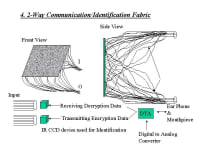
This is a method of employing a 10+" flexible embedded light-emitting alphanumeric display in conjunction with standard night-sensitive security cameras or portable standard issue FLIR equipment to verify the identify of proper authority on individuals from a distance. Fusing PMMA optical fibers into the rear of a jacket defining the letters or symbols of an agency such as the letters, "FBI" keeps the letters invisible until a wearer decides to activate them to be seen.
Two display options are instantly available for a wearer to activate by simply pressing an embedded switch in the sleeve. One will trigger a high intensity light output in the visible range so that surrounding observers are aware of the identity of law enforcement or a person of authority and the second option allows for one to emit Infrared through the letters for only others in a team can identify without allowing casual observers to see the display with the unaided eye.
In addition, the optical fibers embedded in the jacket have four purposes. 1. Light output in the Visible range, 2. IR Output (940nm.), 3. IR encrypted data output and 4. IR receiver channeling IR data through the optical fibers to a sensor buried inside the jacket. The diagrams show the method of displays and one example shows a security person wearing a jacket with embedded optics transmitting in the IR range. This could be useful for casino security monitors to show their security staff in plain clothes via the light output. IFF for military, police, DEA, classified research facilities, and useful for body armor covers to determine if the downed soldier is dead, hurt, and alive via bio-feedback data from the embedded optics no matter what his position on the ground since the optic receptors and transmitters are unaffected outside of any puncture made to the vest.
-
Awards
-
 2012 Top 100 Entries
2012 Top 100 Entries
Like this entry?
-
About the Entrant
- Name:Harry Wainwright
- Type of entry:individual
- Software used for this entry:ppt
- Patent status:pending








